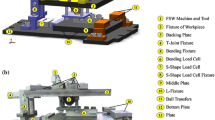Abstract
Advanced process automation is essential to ensure consistent and reliable friction stir welds. This paper illustrates the potential for a better understanding of the influence of certain process parameters on weld properties, through their monitoring and feedback into process control during the welding process. To accomplish this, the force footprint and temperature profile need to be accurately monitored and controlled during welding. In particular, the reaction forces of the tool can be described through a “force footprint” and related to weld quality and dynamic performance. This requires the integration of reliable and accurate sensor output into a computerised control program. Such an instrumented friction stir welding (FSW) set-up has been created. These parameters include tool torque, tool temperature, vertical force of the tool shoulder on the material and the horizontal force profile around the tool during its revolution. Future work will include more complete determination of the temperature profile associated with the thermomechanically affected zone (TMAZ) weld region. The system monitors these parameters during welding and can modify tool speed, feed and forces in response to changing weld conditions.
Similar content being viewed by others
References
Bradley G.R., Hattingh D.G., Yio T.C., James M.N. (2003), Crack Paths in Friction Stir Welded 5083-H321 and 5383-H321 Aluminium Alloys, to be presented at the International Conference on Crack Paths, Parma, Italy, September 2003.
Guerra M., Schmidt C., McClure J.C., Murr L.E., Nunes, A.C. (2003), Flow patterns during friction stir welding, Materials Characterisation, 49, pp. 95–101.
Lienert T.J., Stellwag W.L., Grimmett B.B., Warke R.W. (2003), Friction stir welding studies on mild steel, Welding Journal Supplement, January 2003, pp. 1s-9s.
Libra Measurement Instruments, 2002, TS1000 Torque Sensor Operating Manual.
Bendzsak G.J., North T.H., Smith C.B. (2000), An experimentally validated 3D model for friction stir welding, Proceedings 2nd Friction Stir Welding Symposium, Gothenburg, Sweden, June 2000, TWI Cambridge.
Author information
Authors and Affiliations
Rights and permissions
About this article
Cite this article
Hattingh, D.G., van Niekerk, T.I., Blignault, C. et al. Analysis of the FSW Force Footprint and its Relationship with Process Parameters to Optimise Weld Performance and Tool Design. Weld World 48, 50–58 (2004). https://doi.org/10.1007/BF03266414
Published:
Issue Date:
DOI: https://doi.org/10.1007/BF03266414




